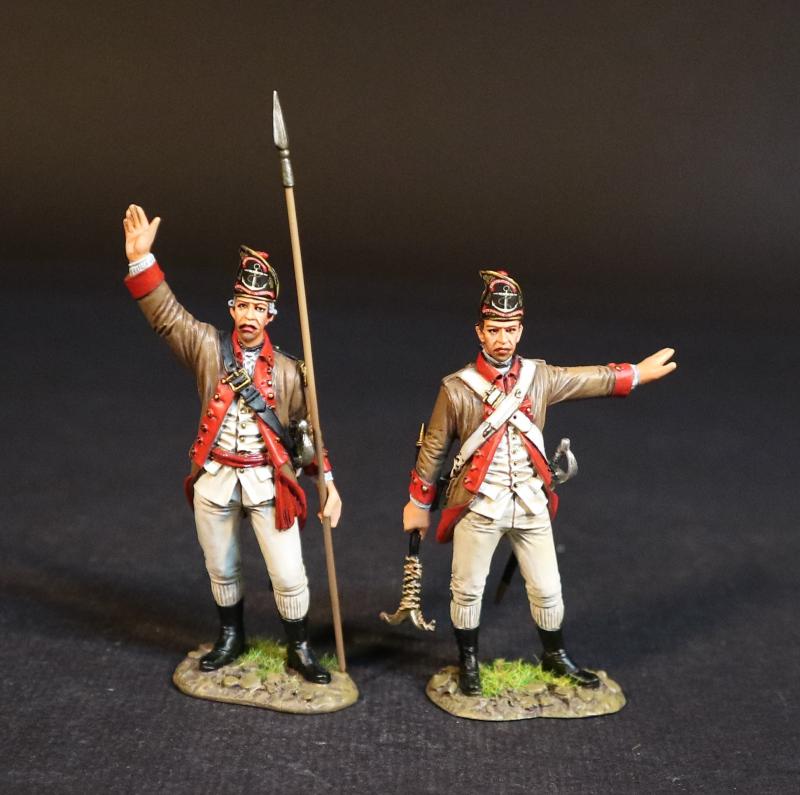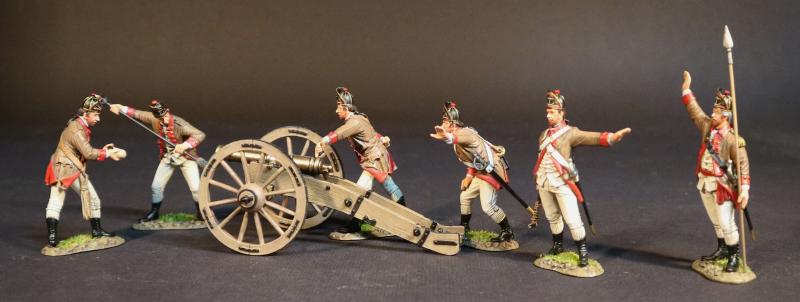Two Artillery Crew, The Rhode Island Train of Artillery, 1775, The American War of Independence 1775-1783--two figures (waving, pike in left hand; waving, fuse lowered in right hand)
$108.00
Item Number: RIART-01
Two Artillery Crew, The Rhode Island Train of Artillery, 1775, The American War of Independence 1775-1783--two figures (waving, pike in left hand; waving, fuse lowered in right hand)
THE AMERICAN WAR OF INDEPENDENCE
THE RHODE ISLAND TRAIN OF ARTILLERY, 1775
The Rhode Island Train of Artillery, also known as the United Train of Artillery, was a significant unit in the Continental Army during the American Revolutionary War.
The unit was formed in 1775 and played a crucial role in the early battles of the war. The unit was reorganized and expanded to include additional companies, contributing to the overall strength of the Continental Army. The unit was involved in various campaigns, including the New York and New Jersey Campaigns, and was instrumental in the Siege of Boston.
The reorganization and expansion of the Rhode Island Militia in 1774 included the formation of two new volunteer companies, the Providence Train of Artillery and the Providence Fusiliers. In April 1775, these were combined to form “The United Company of the Train of Artillery of the Town of Providence”, thereafter usually termed “The United Train of Artillery”. Commanded by Major John Crane, it was assigned to the Rhode Island Brigade, which Brigadier General Nathanael Greene led to join the American forces besieging Boston. Crane was sometimes referred to as “Captain” and the unit as “Crane’s Company”
During the reorganization of the American Army in January 1776, the United Train, or rather those of its men who would re-enlist, were absorbed into Knox’s Massachusetts Artillery Regiment (formerly Colonel Richard Gridley’s), with Crane becoming the latter unit’s “first major”.
The Rhode Island Train of Artillery’s uniform and equipment were notable for their distinctive features, such as the brown faced red coats and leather caps with gold painted anchors.
Like many other American regiments at the beginning of the war, the United Train wore brown coats. Its facings were red, its buttons brass and were stamped with the Rhode Island’s anchor device. Waistcoat and breeches were white linen, and enlisted men wore short black gaiters.
The Train’s headgear was unique, a cap made of six triangular pieces of jacked leather with a small red and brown tuft at the crown. To this was attached a frontal piece whose odd shape may have been inspired by the classic Phrygian or “liberty” cap. Above the Rhode Island anchor motive in the centre is a red scroll with the words “For Our Country” in silver letters. Below the anchor on a gold scroll is the black lettered motto “In Te Domine Speramus”, (In Thee Lord Is Our Hope)
The cannon used in the Revolution by all armies was the standard smooth-bore muzzle-loading gun which had been little changed in the previous two hundred years and which would serve as the principal artillery weapon of most of the world's armies for another hundred. They were cast of iron or bronze; loaded with a prepared cartridge of paper or cloth containing gunpowder, followed by a projectile. It was fired by igniting a goose-quill tube containing gunpowder, or “quickmatch,” inserted into a vent-hole that communicated with the charge in the gun; and when fired, the recoil threw it backward, necessitating it being wrestled back into the firing position by the gun crew.
The main field pieces in the war were the 3-pound galloper and the steady 6-pound field piece.
Iron guns were stronger and, therefore, could withstand bigger charges of gunpowder; most recommendations for the loading of iron cannon called for a powder charge of one-third the weight of the round shot for the gun. The recommendation for bronze guns was restricted to a charge of only one-quarter of the shot weight. Thus, iron guns could usually achieve a greater range than their equivalent in bronze; an iron six-pounder could fire 1500 yards, while a bronze six-pounder could do 1200 yards.
The advantage of bronze guns was that they were much lighter than their iron equivalents of the same caliber, so that bronze guns were preferred for campaigning, even though the range was less, since they could be moved more easily. Another advantage of bronze ordnance was that when, eventually, the gun was so worn as to be unserviceable, it could be melted down and recast; whereas an iron gun could only be scrapped. Last, but not least,, when cannon were lost at sea, bronze guns were salvagable and almost immediately re-usable, whereas even a short time immersed in sea-water was enough to destroy an iron cannon’s usefulness.
British forces used both bronze and iron artillery pieces, and within each caliber group there were generally a number of variant models. This was simply due to the incredibly long, useful lifespan of a muzzle loading cannon.
Note: Cannon and extra crew are not included.
Due to be released in NOVEMBER 2025.

